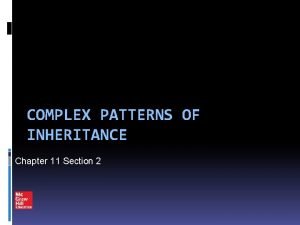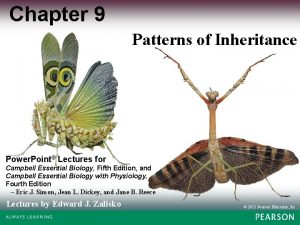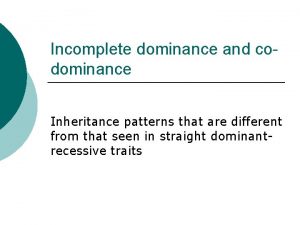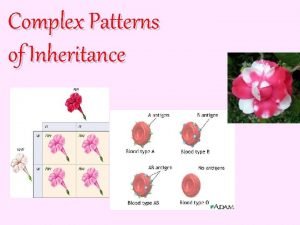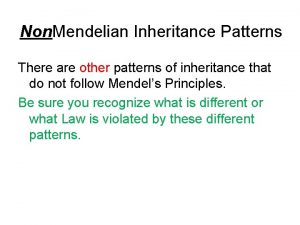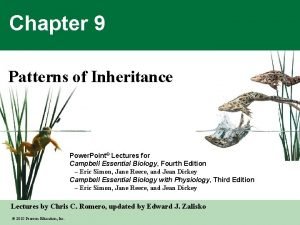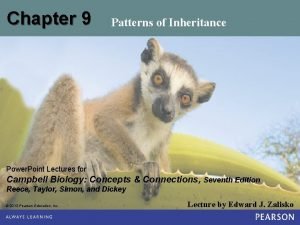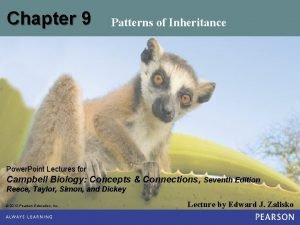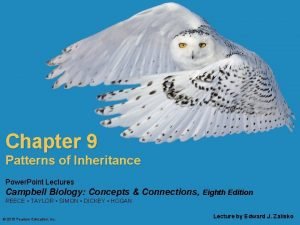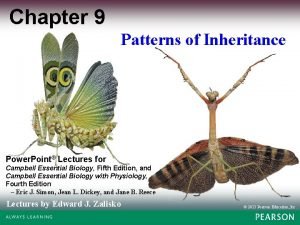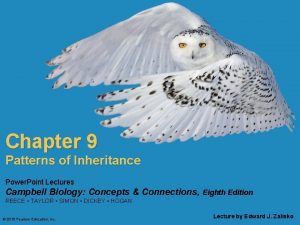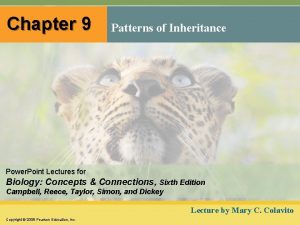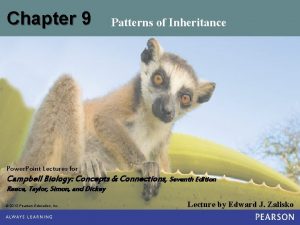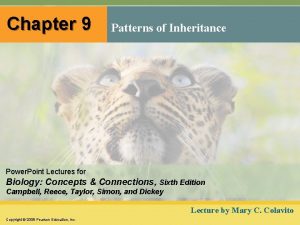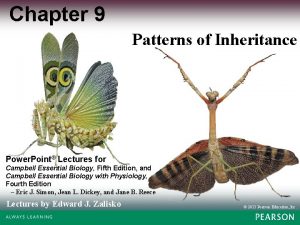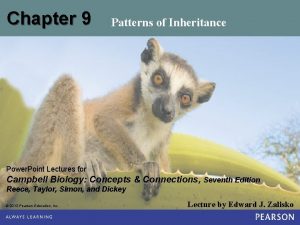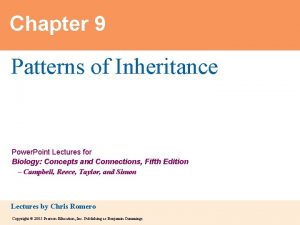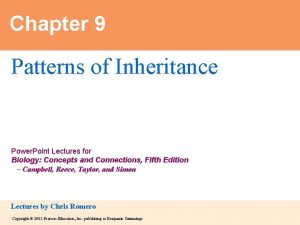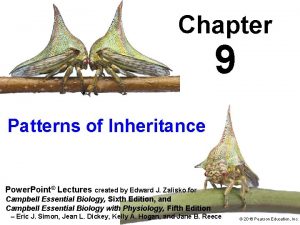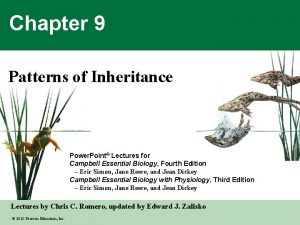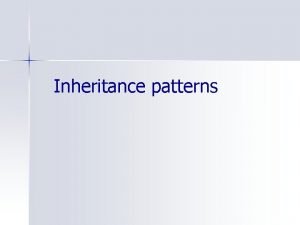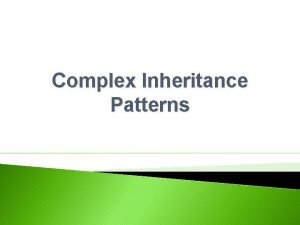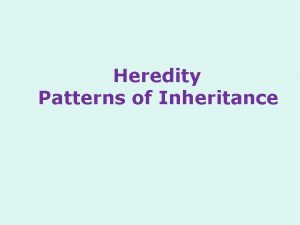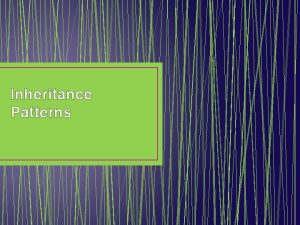Chapter 9 Patterns of Inheritance Power Point Lectures






























- Slides: 30

Chapter 9 Patterns of Inheritance Power. Point Lectures for Campbell Biology: Concepts & Connections, Seventh Edition Reece, Taylor, Simon, and Dickey © 2012 Pearson Education, Inc. Lecture by Edward J. Zalisko

Figure 9. 0_1 Chapter 9: Big Ideas Mendel’s Laws The Chromosomal Basis of Inheritance Variations on Mendel’s Laws Sex Chromosomes and Sex-Linked Genes

9. 5 The law of independent assortment is revealed by tracking two characters at once The following figure demonstrates the law of independent assortment as it applies to two characters in Labrador retrievers: – black versus chocolate color, – normal vision versus progressive retinal atrophy. © 2012 Pearson Education, Inc.

Figure 9. 5 B Blind Phenotypes Genotypes Black coat, normal vision B_N_ Black coat, blind (PRA) B_nn Chocolate coat, normal vision bb. N_ Chocolate coat, blind (PRA) bbnn Mating of double heterozygotes (black coat, normal vision) Bb. Nn Blind Phenotypic ratio of the offspring 9 Black coat, normal vision 3 Black coat, blind (PRA) 3 Chocolate coat, normal vision 1 Chocolate coat, blind (PRA)

Figure 9. 5 B_1 Blind Phenotypes Genotypes Black coat, normal vision B_N_ Black coat, blind (PRA) B_nn Blind Phenotypes Genotypes Chocolate coat, normal vision bb. N_ Chocolate coat, blind (PRA) bbnn

Figure 9. 5 B_2 Mating of double heterozygotes (black coat, normal vision) Bb. Nn Blind Phenotypic ratio of the offspring 9 Black coat, normal vision Blind 1 3 3 Black coat, Chocolate coat, blind (PRA) normal vision

9. 7 Mendel’s laws reflect the rules of probability Using his strong background in mathematics, Mendel knew that the rules of mathematical probability affected – the segregation of allele pairs during gamete formation and – the re-forming of pairs at fertilization. The probability scale ranges from 0 to 1. An event that is – certain has a probability of 1 and – certain not to occur has a probability of 0. © 2012 Pearson Education, Inc.

Evaluating Results Mendel was unable to analyze mathematically how well the actual outcome of his crosses fulfilled his predictions. – Karl Pearson developed the chi-square (χ2) test – Determines whether the observed distribution of individuals in as predicted or occurs by chance. – If there is no difference between the observed and expected classes the value for χ2 will be 0. – The value of χ2 increases with greater difference between the observed and expected classes. – The formula can be expressed as χ2 = Σ (O-E)2 ÷ E – O is # observed and E is # expected

We must now convert χ2 into probability in order to determine if the χ2 value is expected. df (degrees of freedom) = number of classes – 1 We can then use the table below to determine whether the data collected is acceptable. – A p value of less than 0. 05 means that the observations do not meet the expected outcome and needs to be reexamined

9. 8 Genetic traits in humans can be tracked through family pedigrees The inheritance of human traits follows Mendel’s laws. A pedigree – shows the inheritance of a trait in a family through multiple generations, – demonstrates dominant or recessive inheritance, and – can also be used to deduce genotypes of family members. © 2012 Pearson Education, Inc.

Figure 9. 8 A Dominant Traits Recessive Traits Freckles No freckles Widow’s peak Straight hairline Free earlobe Attached earlobe

Figure 9. 8 B First generation (grandparents) Ff Second generation (parents, aunts, FF and uncles) or Ff Third generation (two sisters) Female Male Attached Free ff Ff ff ff Ff Ff Ff ff ff FF or Ff

9. 9 Many inherited disorders in humans are controlled by a single gene Inherited human disorders show either 1. recessive inheritance in which – two recessive alleles are needed to show disease – heterozygous parents are carriers of the disease-causing allele – the probability of inheritance increases with inbreeding, mating between close relatives 2. dominant inheritance in which – one dominant allele is needed to show disease and – dominant lethal alleles are usually eliminated from the population. © 2012 Pearson Education, Inc.

Figure 9. 9 A Normal Dd Parents D D Offspring Normal Dd Sperm d DD Normal Dd Normal (carrier) dd Deaf Eggs d

9. 9 The most common fatal genetic disease in the United States is cystic fibrosis (CF), resulting in excessive thick mucus secretions. The CF allele is – recessive and – carried by about 1 in 31 Americans. Dominant human disorders include – achondroplasia, resulting in dwarfism, and – Huntington’s disease, a degenerative disorder of the nervous system. © 2012 Pearson Education, Inc.

Table 9. 9

9. 10 New technologies can provide insight into one’s genetic legacy New technologies offer ways to obtain genetic information – before conception, – during pregnancy, and – after birth. Genetic testing can identify potential parents who are heterozygous carriers for certain diseases. © 2012 Pearson Education, Inc.

9. 10 New technologies can provide insight into one’s genetic legacy Several technologies can be used for detecting genetic conditions in a fetus. – Amniocentesis extracts samples of amniotic fluid containing fetal cells – Usually performed in the sixteenth week of pregnancy – Chorionic villus sampling removes a sample of chorionic villus tissue from the placenta and permits similar karyotyping and biochemical tests. – Usually performed in the eighth or ninth week of pregnancy © 2012 Pearson Education, Inc.

Figure 9. 10 A Amniocentesis Amniotic fluid extracted Ultrasound transducer Fetus Chorionic Villus Sampling (CVS) Tissue extracted from the Ultrasound chorionic villi transducer Fetus Placenta Chorionic villi Placenta Uterus Cervix Centrifugation Amniotic fluid Fetal cells Several hours Cultured cells Several weeks Karyotyping Biochemical and genetics tests Cervix Uterus Fetal cells Several hours

9. 10 Blood tests on the mother at 14– 20 weeks of pregnancy can help identify fetuses at risk for certain birth defects (neural tube defects and Down syndrome). Fetal imaging enables a physician to examine a fetus directly for anatomical deformities. The most common procedure is ultrasound imaging, using sound waves to produce a picture of the fetus. Newborn screening can detect diseases that can be prevented by special care and precautions. PKU © 2012 Pearson Education, Inc.

Figure 9. 10 B

9. 10 New technologies raise ethical considerations that include – the confidentiality and potential use of results of genetic testing, – time and financial costs, and – determining what, if anything, should be done as a result of the testing. © 2012 Pearson Education, Inc.

9. 12 Many genes have more than two alleles in the population Although an individual can at most carry two different alleles for a particular gene, more than two alleles often exist in the wider population. Human ABO blood group phenotypes involve three alleles for a single gene. The four human blood groups, A, B, AB, and O, result from combinations of these three alleles. The A and B alleles are both expressed in heterozygous individuals, a condition known as codominance. © 2012 Pearson Education, Inc.

9. 12 Many genes have more than two alleles in the population In codominance, – neither allele is dominant over the other and – expression of both alleles is observed as a distinct phenotype in the heterozygous individual. – AB blood type is an example of codominance. © 2012 Pearson Education, Inc.

Figure 9. 12 Blood Group (Phenotype) Genotypes Carbohydrates Present on Red Blood Cells A IAIA or IAi Carbohydrate A Carbohydrate B B IBIB or IBi AB IAIB O ii Antibodies Present in Blood Reaction When Blood from Groups Below Is Mixed with Antibodies from Groups at Left O A B AB Anti-A Carbohydrate A and Carbohydrate B Neither None Anti-A Anti-B No reaction Clumping reaction

9. 14 A single character may be influenced by many genes Many characteristics result from polygenic inheritance, in which a single phenotypic character results from the additive effects of two or more genes. Human skin color is an example of polygenic inheritance. © 2012 Pearson Education, Inc.

Figure 9. 14_1 P generation aabbcc AABBCC (very light) (very dark) F 1 generation Aa. Bb. Cc

Figure 9. 14_2 Sperm F 2 generation 1 8 1 8 1 8 Eggs 1 8 1 8 1 8 1 64 6 64 15 64 20 64 15 64 6 64 1 64

Figure 9. 14_3 Fraction of population 20 64 15 64 6 64 1 64 Skin color All In the Family - video

9. 15 The environment affects many characters Many characters result from a combination of heredity and the environment. skin color is affected by exposure to sunlight susceptibility to diseases, such as cancer, has hereditary and environmental components identical twins show some differences Complex traits are determined by the cumulative effects of genes and the influence of environment Examples: Skin color and IQ Only genetic influences are inherited. © 2012 Pearson Education, Inc.
 Chapter 11 section 2 complex patterns of inheritance
Chapter 11 section 2 complex patterns of inheritance Chapter 9 patterns of inheritance
Chapter 9 patterns of inheritance Chapter 11 section 1 basic patterns of human inheritance
Chapter 11 section 1 basic patterns of human inheritance Chapter 11 section 1 basic patterns of human inheritance
Chapter 11 section 1 basic patterns of human inheritance Chapter 9 patterns of inheritance
Chapter 9 patterns of inheritance Power system lectures
Power system lectures Codominant inheritance patterns
Codominant inheritance patterns Complex patterns of inheritance
Complex patterns of inheritance Mendelian pattern of inheritance
Mendelian pattern of inheritance Power traiangle
Power traiangle Informsu
Informsu Point point power
Point point power Dating serves several important functions that include:
Dating serves several important functions that include: X videos
X videos Rick trebino
Rick trebino Neonatology lectures
Neonatology lectures Data mining lectures
Data mining lectures Medicinal chemistry lectures
Medicinal chemistry lectures Uva template powerpoint
Uva template powerpoint Ludic space
Ludic space Activity planning software project management
Activity planning software project management Molecular biology lectures
Molecular biology lectures Radio astronomy lectures
Radio astronomy lectures Dr sohail lectures
Dr sohail lectures Utilities and energy lectures
Utilities and energy lectures Introduction to web engineering
Introduction to web engineering Do words have power
Do words have power Frcr physics lectures
Frcr physics lectures Frcr physics lectures
Frcr physics lectures Introduction to recursion
Introduction to recursion Guyton physiology lectures
Guyton physiology lectures
